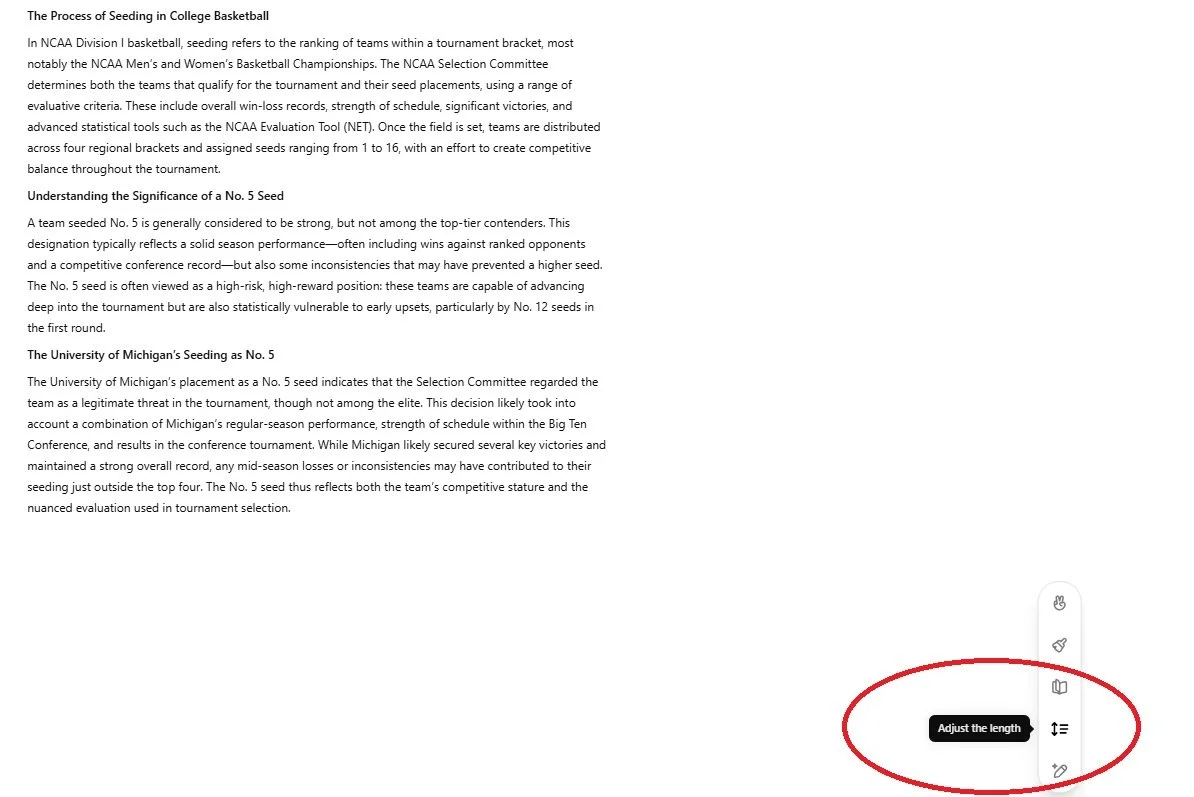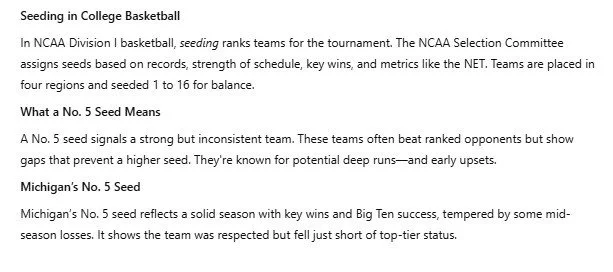More Canvas Tools
In my last blog post, I shared how Canvas, a newer tool that’s available through ChatGPT, lets you edit longer content interactively. If you haven’t read that post, I recommend starting there.
In this post, I’ll show you four additional Canvas features: adjusting the length, changing the reading level, adding a final polish, and sprinkling in a few emojis. As always, the best way to understand how these features work is to see them in action.
I asked ChatGPT to write three paragraphs explaining how basketball teams are seeded and why the University of Michigan’s basketball team was seeded No. 5. As I write this, we are in the midst of March Madness. Not being a sports person but living in a sports town (Ann Arbor, Michigan), I wanted to have a better understanding—or at least keep up with my son when he talks about it!
Here's the original text:
Original Text About Seeding in Basketball
Adjusting the Length
Let’s say I want to make this explanation shorter. I open up Canvas (see my previous post on how to do this), move my cursor to the bottom right side of my screen, and select “Adjust the length.”
Adjusting the Length
You can choose to make your selection shorter or longer using the length adjustment slider as shown here:
Length Adjustment Slider
I move the slider down to make my text shorter. This is what ChatGPT returns to me:
Shortened Text About Seeding in Basketball
This text is about 50 percent shorter than the original and retains all the key information. If you want to control how much shorter, just include that in your prompt: “Make this text about 25 percent shorter while keeping the same tone.” If you don’t like the result, you can always revert to your original text.
Sometimes you may want to expand on an idea or paragraph. Just select the paragraph and then move the “Adjust the length” slider up. Again, you always have the option to accept or reject what ChatGPT offers you.
Changing the Reading Level
If you’re writing for a general audience or students at a specific grade level, the “Change reading level” option is a huge time-saver. You can prompt ChatGPT to shift the reading level up or down by specifying a grade level or asking for simpler or more advanced language. You can find this tool in the same location as the tool to adjust the length:
Changing the Reading Level
Similar to the length adjustment slider, you can move the reading level slider up or down to modify the reading level. The original paragraphs on basketball were written for college-level readers. I moved the reading level slider down to change the text to a reading level for middle schoolers. This is what it returned:
Text at a Middle-School Reading Level
Adding Final Polish
Canvas’s tools also include a “Polish” option that you can apply to any paragraph or section.
This tool goes beyond correcting mistakes; it enhances rhythm, word choice, and style. I often use this feature when I know a sentence could be better but am stuck.
You still get to review each suggestion (nothing is automatic), so you can accept only what actually helps.
Sprinkling in Emojis (Yes, Really)
You can also prompt ChatGPT to add emojis for tone, clarity, or fun through Canvas’s tools. I used it on the text for middle school readers, as that seemed like the perfect audience for emojis. That said (as you can see below), use this feature judiciously. I often delete at least a few emojis after they’re added—it’s easy to overdo it.
Sprinkling in Emjois
On that note, 🏀💙 GO BLUE! 💛🏀.
If you enjoyed this post, consider signing up for my blog (see the Editing with AI subscriber bar at the bottom of the page). You’ll be notified when the next post is up and of tips and classes I think are useful. I promise to never misuse your information.







